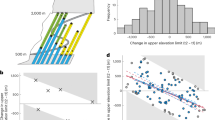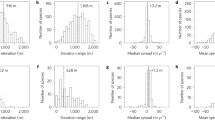Abstract
Species from many different habitats are responding to recent climate change. Mountainous areas are of particular interest as they provide pronounced gradients and have experienced above-average temperature increases. Data from the beginning of the 20th century of both the upper and lower range limits of plants of the European Alps were updated a century later and analyzed in order to identify common trends and deviating patterns of shifts at opposing ends of species’ ranges. At the upper limit, there was a strong trend towards an increase in species richness per summit, including 33 species that were recorded for the first time on any of the investigated summit areas. The species experienced a consistent upward shift exceeding 100 elevational meters, and 49 out of the 125 investigated species shifted upwards to a present altitude which is higher than any reported occurrence in the region one century ago. The response at the lower range limit was more heterogeneous and suggests species-specific differences in responsiveness and response patterns. With this approach of the combined analysis of upper and lower range limits along elevational gradients, it is possible to identify candidate species that might not keep pace with climate change, and thus, might face an increased risk of extinction with continued global warming.
Zusammenfassung
Tier- und Pflanzenarten aus den verschiedensten Lebensräumen zeigen bereits Reaktionen auf den Klimawandel. Gebirgslebensräume sind in diesem Zusammenhang von besonderem Interesse, da sie ausgeprägte Gradienten aufweisen und eine im Vergleich zum globalen Durchschnitt stärkere Erwärmung erfahren haben. Detaillierte Angaben zu den höchst- und tiefstgelegenen Vorkommen von Pflanzenarten in den Alpen liegen von anfangs des 20. Jahrhunderts vor. Diese Angaben dienten als Grundlage für die vorliegende Arbeit. Sie wurden ein Jahrhundert später aktualisiert und im Hinblick auf gemeinsame Trends bzw. divergierende Veränderungsmuster an den jeweiligen Arealgrenzen ausgewertet. An der Arealobergrenze war ein deutlicher Trend zu einer höheren Artenzahl pro Gipfel zu verzeichnen, darunter 33 Arten, welche zum ersten Mal überhaupt auf den untersuchten Gipfelbereichen nachgewiesen werden konnten. Die Arten erfuhren eine deutliche Aufwärtsverschiebung, die in manchen Fällen mehr als 100 Höhenmeter betragen kann, und 49 der 125 untersuchten Arten kommen mittlerweile in einer Höhe vor, die oberhalb der früher dokumentierten regionalen Höchstgrenze liegt. Die Veränderungen an der Untergrenze zeigen hingegen ein deutlich heterogeneres Bild und weisen auf unterschiedliche, artspezifische Reaktionsgeschwindigkeiten und -muster hin. Allerdings zeigte sich im Gegensatz zur Arealobergrenze kein deutlicher Aufwärtstrend der Arealuntergrenze bei den untersuchten Arten. Mit dem Ansatz der kombinierten Analyse der Veränderungen an der Arealober- und untergrenze lassen sich Arten erkennen, welche möglicherweise nicht mit dem Klimawandel Schritt halten können und damit einem erhöhten Aussterberisiko im Zusammenhang mit der fortschreitenden Erderwärmung ausgesetzt werden.




Similar content being viewed by others
References
Aeschimann D, Lauber K, Moser DM, Theurillat J-P (2004) Flora alpina. Haupt, Bern
Becker A, Körner C, Brun JJ, Guisan A, Tappeiner U (2007) Ecological and land use studies along elevational gradients. Mt Res Dev 27:58–65
Braun J (1913) Die Vegetationsverhältnisse der Schneestufe der Rätisch-Lepontischen Alpen–Ein Bild des Pflanzenlebens an seinen äussersten Grenzen. Denkschr Schweiz Nat forsch Ges 48:1–347
Braun-Blanquet J (1955) Die Vegetation des Piz Languard, ein Massstab für Klimaänderungen. Sven Bot Tidskr 49:1–9
Breshears DD, Huxman TE, Adams HD, Zou CB, Davison JE (2008) Vegetation synchronously leans upslope as climate warms. Proc Natl Acad Sci USA 105:11591–11592
Burga CA, Frei E, Reinalter R, Walther G-R (2007) Neue Daten zum Monitoring alpiner Pflanzen im Engadin. Ber d Reinh-Tüxen-Ges 19:37–43
Camenisch M (2002) Veränderungen der Gipfelflora im Bereich des Schweizerischen Nationalparks: Ein Vergleich über die letzten 80 Jahre. Jahresber Nat forsch Ges Graubünden 111:27–37
Cannone N, Sgorbati S, Guglielmin M (2007) Unexpected impacts of climate change on alpine vegetation. Front Ecol Environ 5:360–364
Epstein HE, Walker MD, Chapin FS, Starfield AM (2000) A transient nutrient-based model of Arctic plant community response to climatic warming. Ecol Appl 10:824–841
Grabherr G, Gottfried M, Pauli H (1994) Climate effects on mountain plants. Nature 369:448
Grabherr G, Gottfried M, Pauli H (2001) Long-term monitoring of mountain peaks in the Alps. In: Burga CA, Kratochwil A (eds) Biomonitoring: general and applied aspects on regional and global scales. Tasks for vegetation science 35. Kluwer, Dordrecht, pp 153–177
Hampe A, Petit RJ (2005) Conserving biodiversity under climate change: the rear edge matters. Ecol Lett 8:461–467
Hofer HR (1992) Veränderungen in der Vegetation von 14 Gipfeln des Berninagebietes zwischen 1905 und 1985. Ber Geobot Inst Eidgenöss Tech Hochsch Stift Rübel 58:39–54
Holzinger B, Hülber K, Camenisch M, Grabherr G (2008) Changes in plant species richness over the last century in the eastern Swiss Alps: elevational gradient, bedrock effects and migration rates. Plant Ecol 195:179–196
Huntley B (1991) How plants respond to climate change—migration rates, individualism and the consequences for plant communities. Ann Bot 67:15–22
Jurasinski G, Kreyling J (2007) Upward shift of alpine plants increases floristic similarity of mountain summits. J Veg Sci 18:711–718
Kammer PM, Schob C, Choler P (2007) Increasing species richness on mountain summits: upward migration due to anthropogenic climate change or re-colonisation? J Veg Sci 18:301–306
Klanderud K (2005) Climate change effects on species interactions in an alpine plant community. J Ecol 93:127–137
Körner C (2003) Alpine plant life: functional plant ecology of high mountain ecosystems. Springer, Berlin
Körner C (2007) The use of ‘altitude’ in ecological research. Trends Ecol Evol 22:569–574
Krajick K (2004) All downhill from here? Science 303:1600–1602
Kullmann L (2002) Rapid recent range-margin rise of tree and shrub species in the Swedish Scandes. J Ecol 90:68–77
Kullmann L (2006) Long-term geobotanical observations of climate change impacts in the Scandes of West-Central Sweden. Nordic J Bot 24:445–467
Le Roux PC, McGeoch MA (2008) Rapid range expansion and community reorganization in response to warming. Glob Change Biol 14:2950–2962
Lenoir J, Gégout JC, Marquet PA, de Ruffray P, Brisse H (2008) A significant upward shift in plant species optimum elevation during the 20th century. Science 320:1768–1771
Lesica P, McCune B (2004) Decline of arctic-alpine plants at the southern margin of their range following a decade of climatic warming. J Veg Sci 15:679–690
Miller-Rushing AJ, Primack RB (2008) Global warming and flowering times in Thoreau’s Concord: a community perspective. Ecology 89:332–341
Nogués-Bravo D, Araújo MB, Martinez-Rica JP, Errea MP (2007) Exposure of global mountain systems to climate change. Glob Environ Chang 17:420–428
Parmesan C (2006) Ecological and evolutionary responses to recent climate change. Annu Rev Ecol Evol Syst 37:637–669
Parmesan C, Yohe G (2003) A globally coherent fingerprint of climate change impacts across natural systems. Nature 421:37–42
Parolo G, Rossi G (2008) Upward migration of vascular plants following a climate warming trend in the Alps. Basic Appl Ecol 9:100–107
Pauli H, Gottfried M, Reiter K, Klettner C, Grabherr G (2006) Signals of range expansions and contractions of vascular plants in the high Alps: observations (1994–2004) at the GLORIA master site Schrankogel, Tyrol, Austria. Glob Chang Biol 12:1–10
Post E, Pedersen C (2008) Opposing plant community responses to warming with and without herbivores. Proc Natl Acad Sci USA 105:12353–12358
Price MV, Waser NM (2000) Responses of subalpine meadow vegetation to four years of experimental warming. Ecol Appl 10:811–823
Rebetez M, Reinhard M (2008) Monthly air temperature trends in Switzerland 1901–2000 and 1975–2004. Theor Appl Climatol 91:27–34
Reinalter R (2004) Zur Flora der Sedimentsgebiete im Umkreis der südrätischen Alpen, Livignasco, Bormiese und Engiadin’Ota (Schweiz-Italien). Denkschriften der Schweizerischen Akademie der Naturwissenschaften, Band 105. Birkhäuser, Basel
Root TL, Price JT, Hall KR, Schneider SH, Rosenzweig C, Pounds JA (2003) Fingerprints of global warming on wild animals and plants. Nature 421:57–60
Rosenzweig C, Casassa G, Karoly DJ, Imeson A, Liu C, Menzel A, Rawlins S, Root TL, Seguin B, Tryjanowski P (2007) Assessment of observed changes and responses in natural and managed systems. In: Parry ML, Canziani OF, Palutikof JP, van der Linden PJ, Hanson CE (eds) Climate Change 2007: impacts, Adaptation and vulnerability. Contribution of working group II to the fourth assessment report of the intergovernmental panel on climate change. Cambridge University Press, Cambridge, pp 79–131
Rübel E (1912) Pflanzengeographische Monographie des Berninagebietes. Engelmann, Leipzig
Salzer MW, Hughes MK, Bunn AG, Kipfmueller KF (2009) Recent unprecedented tree-ring growth in bristlecone pine at the highest elevations and possible causes. Proc Natl Acad Sci USA 106:20348–20353
Tingley MW, Beissinger SR (2009) Detecting range shifts from historical species occurrences: new perspectives on old data. Trends Ecol Evol 24:625–633
Vittoz P, Bodin J, Ungricht S, Burga CA, Walther G-R (2008) One century of vegetation change on Isla Persa, a nunatak in the Bernina massif in the Swiss Alps. J Veg Sci 19:671–680
Vittoz P, Dussex N, Wassef J, Guisan A (2009) Diaspore traits discriminate good from weak colonisers on high-elevation summits. Basic Appl Ecol 10:508–515
Walther G-R (2004) Plants in a warmer world. Perspect Plant Ecol Evol Syst 6:169–185
Walther G-R (2010) Community and ecosystem responses to recent climate change. Phil Trans R Soc B 365:2019–2024
Walther G-R, Burga CA, Edwards PJ (eds) (2001) ‘Fingerprints’ of climate change—adapted behaviour and shifting species ranges. Kluwer/Plenum, New York
Walther G-R, Post E, Convey P, Menzel A, Parmesan C, Beebee TJC, Fromentin J-M, Hoegh-Guldberg O, Bairlein F (2002) Ecological responses to recent climate change. Nature 416:389–395
Walther G-R, Beißner S, Burga CA (2005a) Trends in the upward shift of alpine plants. J Veg Sci 16:541–548
Walther G-R, Hughes L, Vitousek P, Stenseth NC (2005b) Consensus on climate change. Trends Ecol Evol 20:648–649
Walther G-R, Nagy L, Heikkinen RK, Penuelas J, Ott J, Pauli H, Pöyry J, Berger S, Hickler T (2010) Observed climate-biodiversity relationships. In: Settele J, Penev L, Georgiev T, Grabaum R, Grobelnik V, Hammen V, Klotz S, Kotarac M, Kühn I (eds) Atlas of biodiversity risks. Pensoft Publishers, Sofia, pp 74–75
Acknowledgments
Research was supported by the DFG (WA 1523/6-1) for GRW, by the EC within the FP 6 Integrated Project ‘ALARM’ (GOCE-CT-2003-5006675) for JB and GRW, and by the Dr. Joachim De Giacomi-Foundation as well as Bergbahnen Oberengadin for EF. GRW thanks E. Beever and J. Belant for the organization of and invitation to the symposium at The Wildlife Society (TWS) conference in Tucson, AZ. Participation was made possible with the funding of TWS, U.S.G.S., and DFG (German Research Foundation; KON 1240/2007 & WA 1523/8-1) and served as stimulus for the compilation of this article. We would like to thank M. Heggli and R. Reinalter for field assistance, J.-L. Dupouey and C. Burga for valuable discussions, and E. Beever, M. Heggli, J.S. Campbell, S. Wipf and two anonymous reviewers, whose comments improved drafts of the manuscript.
Author information
Authors and Affiliations
Corresponding author
Additional information
Responsible editor: Sonja Wipf.
Rights and permissions
About this article
Cite this article
Frei, E., Bodin, J. & Walther, GR. Plant species’ range shifts in mountainous areas—all uphill from here?. Bot. Helv. 120, 117–128 (2010). https://doi.org/10.1007/s00035-010-0076-y
Received:
Accepted:
Published:
Issue Date:
DOI: https://doi.org/10.1007/s00035-010-0076-y




